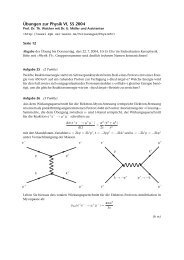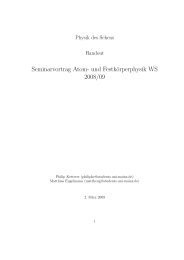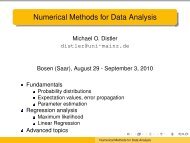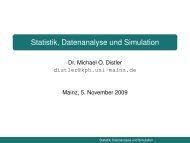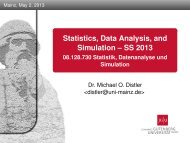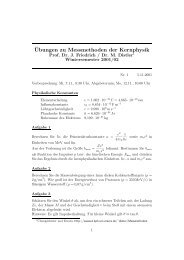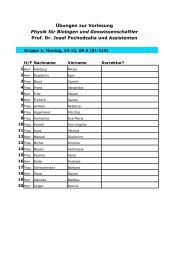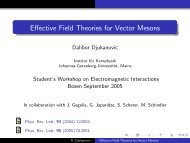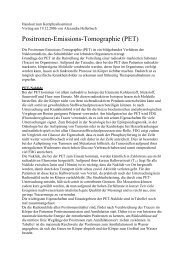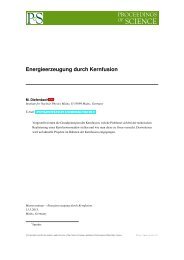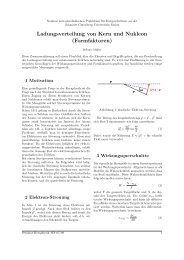A Classic Thesis Style - Johannes Gutenberg-Universität Mainz
A Classic Thesis Style - Johannes Gutenberg-Universität Mainz
A Classic Thesis Style - Johannes Gutenberg-Universität Mainz
You also want an ePaper? Increase the reach of your titles
YUMPU automatically turns print PDFs into web optimized ePapers that Google loves.
1.4 theoretical models 11<br />
For those processes in which the quark masses can be neglected and<br />
the external momenta are small, the effective field theory constructed<br />
with a Lagrangian consistent with the (approximate) chiral symmetry<br />
of QCD, called Chiral perturbation theory (ChPT), provides a valid<br />
computational scheme [12]. Chiral lagrangians result very successful<br />
for pion electroproduction but due the relatively large strange quark<br />
mass serious difficulties appear in the calculation of processes involving<br />
kaons. ChPT kaon production calculations have been performed<br />
only up to 100 MeV over threshold. The results are encouraging as<br />
the comparison with the existing data is reasonably good but still<br />
insufficient for a theoretical description of Kaos measurements where<br />
energies over threshold of 150 MeV have been used [13].<br />
A successful description of photoproduction has been obtained with<br />
hadronic field theories. This approach is based on effective degrees<br />
of freedom, mesons and baryons treated as a single entities, characterized<br />
by properties such as mass, charge, spin, form factors, and<br />
coupling constants (e.g. [14, 15, 16]). As we have seen, electroproduction<br />
processes can be formally reduced to the binary process of<br />
photoproduction by a virtual photon.<br />
The different s, t and u diagrams for the lowest-order p(γ ∗ ; K)Y<br />
amplitude can be classified in non-resonant and resonant types, and<br />
are shown in Figs. 3 and 4 respectively. The names of the different<br />
channels correspond to the relevant Mandelstam variable describing<br />
the momentum exchanged in a particular diagram. Only hyperon<br />
resonances can be exchanged in the u-channel due to the conservation<br />
of strangeness. Finite decay widths are taken into account by<br />
modifying the propagator denominators in the s channel with the<br />
substitution: s − m 2 R → s − m2 R + imrΓR where mR is the mass of the<br />
interchanged particle in the diagram and ΓR its width. Also visible in<br />
Fig. 4 is a high precision measurement by the CLAS collaboration for<br />
the total photoproduction cross-section as a function of the CM energy.<br />
A clear resonance structure sitting on a continuous background near<br />
threshold can be observed. This general structure is nicely explained<br />
by the isobaric model as only the propagators in the s-channel terms<br />
involving an excited state can reach their poles. The t- and u-channel<br />
diagrams and the ground state nucleon s-channel term can not reach<br />
their poles because of energy-momentum conservation and can be<br />
seen as background contributions.<br />
There is some ambiguity with respect to the structure of the KYN<br />
vertex in the sense that pseudo-scalar or pseudo-vector coupling for<br />
the interaction Lagrangians are possible. This issue has been studied<br />
by several authors but neither of the two possibilities has yet been<br />
confirmed as correct [17].<br />
This approximation, where unitarity is lost, gives rise to the so called<br />
isobaric models (originally introduced by [18]). Coupled-channels (or<br />
rescattering) effects can be analyzed in the more general framework



